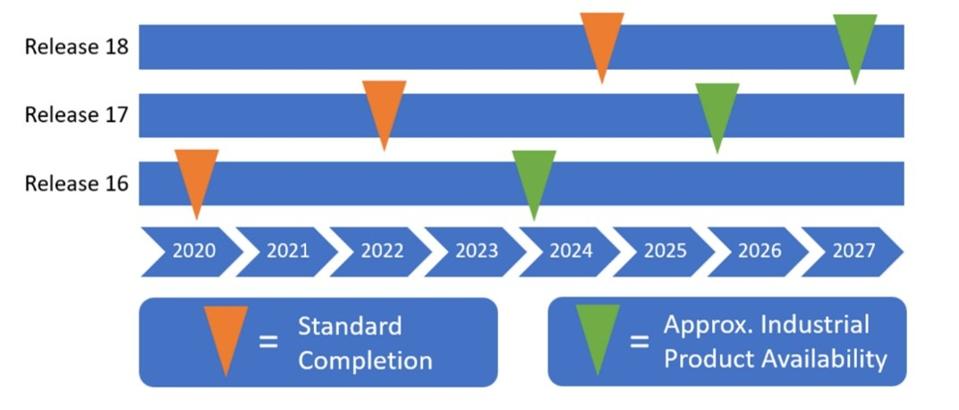5G Holds Great Promise For Industry, But Challenges Remain
While 5G has revolutionized connectivity in many industries by allowing for better data transfer and communication in both traditional and non-traditional use cases. However, current 5G technologies may not be a one-size-fits-all solution for consumers and industrial users.
RedCap 5G Will Serve the Middle Ground Between 5G and Low-Power Wireless Technologies
ARC Advisory Group
5G promises high bandwidth, low latency, and massive IoT device connectivity. For industry, the ability to better connect machines, objects, and devices is what is driving excitement for this technology. Patrick Arnold, a research analyst at ARC Advisory Group, says that suppliers of industrial solutions are responding by investing in new product design and incorporating 5G into their portfolios.
“5G” is the 5th generation mobile network. It is based on a new global wireless standard.
In the industrial realm, solutions are what drive the adoption of new technology,” Mr. Arnold explained. In smart manufacturing, for example, the deployment of a multitude of sensors and devices for real-time monitoring of machinery, predictive maintenance, and quality control are primary use cases.
Mr. Arnold continued, “in logistics and smart warehouses, the tracking and coordination of numerous assets, some of which operate autonomously, benefit from the massive IoT device capacity and low-latency communication offered by 5G. In the realm of mobile assets like vehicles, robots, and drones, 5G’s reliable uptime and low latency enable real-time data exchange crucial for navigation, coordination, and decision-making.”
A key strength of 5G is its capability to connect non-traditional assets that would prove challenging for wireline infrastructure or other wireless technologies. In remote assets, including those dispersed over a wide area or in challenging industrial environments, 5G can facilitate efficient data transmission and control. These features position 5G “as a transformative technology for connecting a diverse array of assets beyond the conventional scope” of today’s use cases. This unlocks new possibilities for innovation and optimization in various industries,” Mr. Arnold explained. One example is that maintenance personnel can benefit from the swift and reliable transfer of large datasets, including heavy image and video data, to allow them to do remote diagnostics and maintenance.
Challenges and Delays to Industrial 5G Adoption
However, Mr. Arnold said, “the enthusiasm surrounding 5G in the industrial sector has, to some extent, outpaced the technology’s readiness for widespread deployment. The hype generated by the potential benefits of 5G has led to heightened levels of interest among end users, with many industries expressing eagerness to leverage its capabilities before the technology has matured sufficiently for industrial-grade applications. This premature enthusiasm has prompted certain challenges, “as the technology’s promises have not always aligned with the current practicalities of its implementation in industrial settings.”
COVID-19 slowed the maturation of this technology. The pandemic disrupted collaboration and coordination efforts among the standards organization and industry stakeholders. The pandemic also meant that suppliers experienced component shortages. These lags affected the timeline for the widespread adoption of 5G in industrial applications.
Moreover, during the extended trial period, industrial users have faced hurdles in deploying 5G due to associated costs and complexities with this technology. “The deployment challenges,” Mr. Arnold explained, “coupled with the established presence and familiarity with competing technologies such as Wi-Fi, have led some industries to reassess the immediate feasibility and benefits of transitioning to 5G.”
Reassess the immediate feasibility and benefits of transitioning to 5G
Another lingering concern in the industrial landscape is the potential impact of continuous improvements to 5G. As 5G evolves, Mr. Arnold continued, “there are apprehensions about the compatibility of existing industrial infrastructure with future advancements which will require major hardware replacements.”
There is also a significant knowledge gap, among telecommunications experts and industrial stakeholders, regarding the requirements unique to mission-critical industrial 5G deployments. Telecommunications providers, Mr. Arnold stated, “are often more accustomed to consumer-focused applications.” They struggle to serve the stringent demands of industrial settings.
These concerns mean that industrial companies need to carefully consider how to integrate this new technology into their long-term strategies. Many large enterprises that are on the cutting edge of technological innovation are taking a “wait and see” approach.
Estimated Timeline for 5G Standard Completion and Industrial Hardware Availability
ARC Advisory Group
But Help is on the Horizon
While normal 5G networks are designed to provide high data rates, low latency, and massive device connectivity for a broad range of business use cases, the Reduced Capability (RedCap) 5G specification is streamlined to address the specific needs of less intensive applications. The RedCap specification serves as an alternative that provides a respectable level of functionality with better battery life performance. It better balances cost and energy efficiency.
For use cases like smart sensing, utility connectivity, wearable devices, and video surveillance systems, the massive bandwidth and accompanying high power consumption of 5G is “overkill.” Wi-Fi often lacks the required range and reliability to serve these applications.
Mr. Arnold summed it up by saying, “it’s crucial to recognize that the adoption of these features is expected to unfold gradually rather than as a revolutionary change.”
This article was written by Steve Banker from Forbes and was legally licensed through the DiveMarketplace by Industry Dive. Please direct all licensing questions to legal@industrydive.com.
![]()


